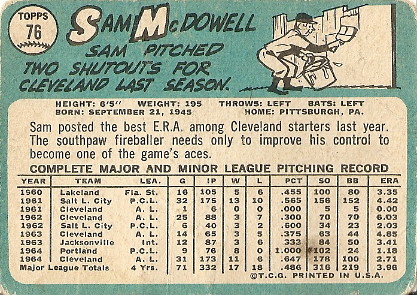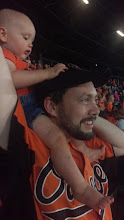
Towering over most of his peers at 6'5" and more than 200 pounds, Sam McDowell did most things hard and fast. Signed by the Tribe before his 18th birthday, the native of nearby Pittsburgh made his Indians debut in 1961, at the end of his second pro season. He struck out batters by the handful, but wallked nearly as many. That probably contributed to his tentative grasp on a roster spot; Sam did not spend a full season in the bigs until 1965. He started to put things together in 1964, when he went a combined 19-6 at Portland and Cleveland and posted a 2.70 ERA in the majors.
The following year was a memorable one for Sam. The 22-year-old was an All-Star (the first of six selections for him), going 17-11 with 14 complete games and a league-best 2.18 ERA. He also led the A.L. with an absurd 325 strikeouts (not to mention 132 walks and 17 wild pitches). Despite topping the Junior Circuit in K's again in 1966 (225) as well as shutouts (five), McDowell dropped to nine wins. After being unseated by Boston's Jim Lonborg for 1967's strikeout title (by a 246-236 margin), he returned to the top of the league in whiffs in 1968 (283) and 1969 (279). Sam also posted a miniscule 1.81 ERA in 1968, placing him as runner-up to teammate Luis Tiant. The southpaw's win totals were gradually climbing back to the heights of 1965, and he set a new career high with 18 victories in 1969. But the best was just around the corner.
1970 was McDowell's finest all-around year on the mound. He went 20-12 with 19 complete games, a 2.92 ERA, and 304 strikeouts. It was the fifth and last time he led the league in K's, with all five crowns coming in a six-year span. He was rewarded by The Sporting News, which named him Pitcher of the Year.
After following up with a down year by his own standards (13-17, 8 CG, 192 K, 3.40 ERA, 1.46 ERA), Sam found himself as one half of a challenge trade. He was sent to the Giants for fellow All-Star pitcher Gaylord Perry. The Indians would soon find that they had gotten the better of the deal; Perry won 72 games in three-and-a-half years in Cleveland and then netted them Jim Bibby, Rick Waits, Jackie Brown, and $100,000 in a trade with Texas. McDowell, sadly, was already running out of gas. He won just 11 games with an ERA near 4.50 before San Francisco cut their losses and sold him to the Yankees in June 1973. The lefty had a mediocre 29-game stint with the Yankees before coming home to Pittsburgh in 1975. Then 32 years of age, he posted a 2.86 ERA in 34 and two-thirds innings (mostly in relief) as a swan song to his career.
Sam McDowell was a force to be reckoned with in his prime, which helped him to 141 career wins and 103 complete games. He struck out 2,453 total batters, and his ratios of 8.86 K/9 IP and 7.03 H/9 IP are each still ninth-best all-time. Of course, a more disciplined approach may have lengthened both his peak and his career as a whole. He did top the league in walks allowed on five occasions, and in wild pitches thrice. It's also been said that his considerable appetite for alcohol hastened his decline. After his career ended, the drinking worsened, costing him his family. In the early eighties McDowell, deeply in debt, managed to rehabilitate. He repaid his creditors, earned a degree in sports psychology and addiction from the University of Pittsburgh, and found work as a counselor for the Rangers, Blue Jays, and eventually for the Major League Baseball Players' Alumni Association. He remarried in 2001 and started a retirement community in Florida for ex-players.
Fun fact: The character of Sam Malone, the alcoholic ex-Red Sox pitcher played by Ted Danson on the popular sitcom Cheers, was based on Sam McDowell.
Bonus fun fact: Sam played one-third of an inning at second base and two-thirds of an inning at first base in 1970, as manager Alvin Dark switched back and forth between the lefthander and righty Dean Chance. In the former instance, he even recorded a putout, taking a throw from third baseman Eddie Leon to force Frank Howard at second!



Wow the 64 card really is QUITE similar.
ReplyDeleteSam McDowell was a great favorite on mine back in the day. He started the first game of a doubleheader against the Yankees in 1970 in the one of best days I've ever spent in a ball park.
ReplyDeleteJune 1970, Yankee Stadium, Indians-Yankees midweek doubleheader. As usual my buddy and I slipped an usher a couple of bucks and were led to sweet box seats behind home plate that he knew would be open. The highlights:
-Bobby Murcer hitting four straight homers over the two games (including a couple of upper deck jobs) with a walk mixed in IIRC.
-A bench clearing fight at home plate between Stan Bahnsen and Vada Pinson after Bahnsen tagged Pinson out when he tried to score on a pitch that got away behind home plate. Pinson got tossed and had to be dragged off the field.
-Some joker tossed a cherry bomb out of the upper deck above us which landed near home causing Indian catcher Ray Fosse to jump about four feet in the air. (We jumped, too, even though we saw it coming down!)
-Steve Hamilton entering the first game in relief and tossing his 'Folly Floater' to Tony Horton who looked very silly as he wiffed badly at two of them. Horton then popped one up to the catcher and proceeded to bow to Hamilton and crawl bad to the dugout on his hands and knees.
Bob, another excellent first-hand account of baseball history! I'd heard about that particular "Folly Floater" anecdote...it's awesome that you were there to see it. :)
ReplyDeleteSam appears to be in front of the visitor's dugout (3rd base side) at Municipal Stadium in home white uni. Looks like road grey Red Sox shirt, hat in background. Definitely not Salmon! Sam didn't come up in '64 until May 30.
ReplyDelete